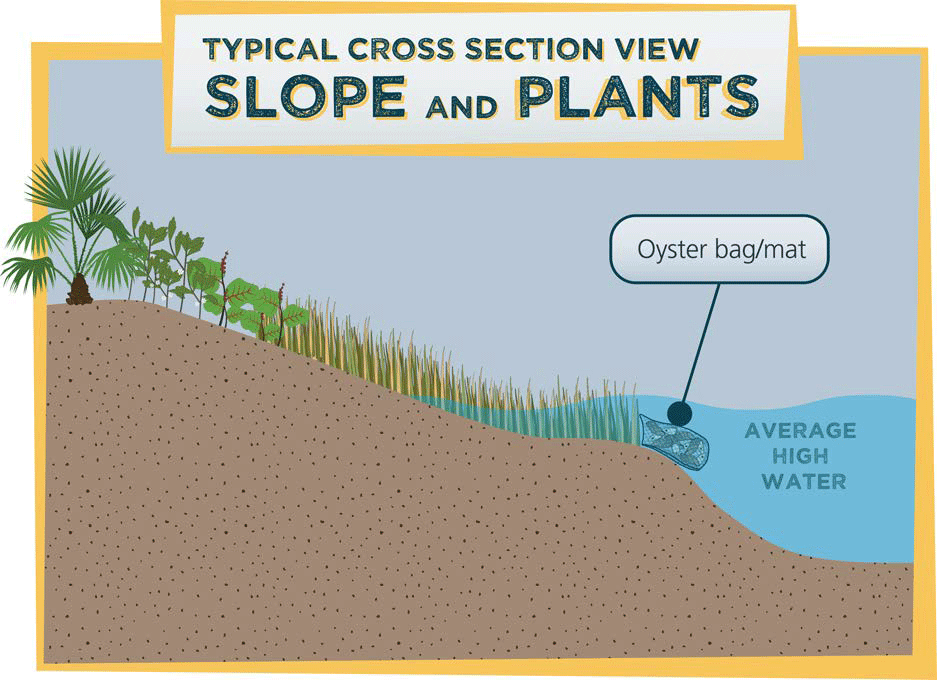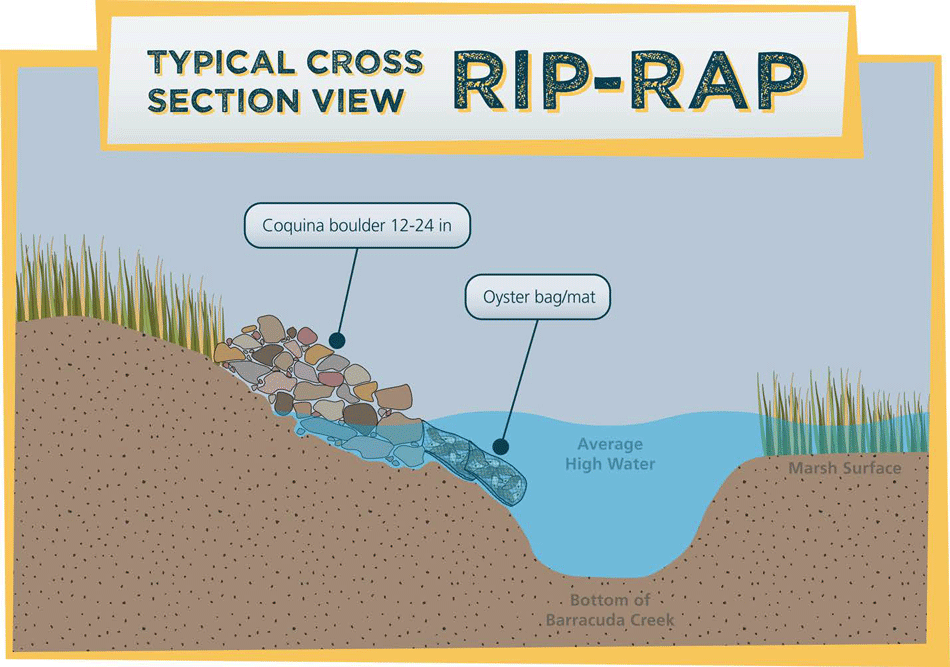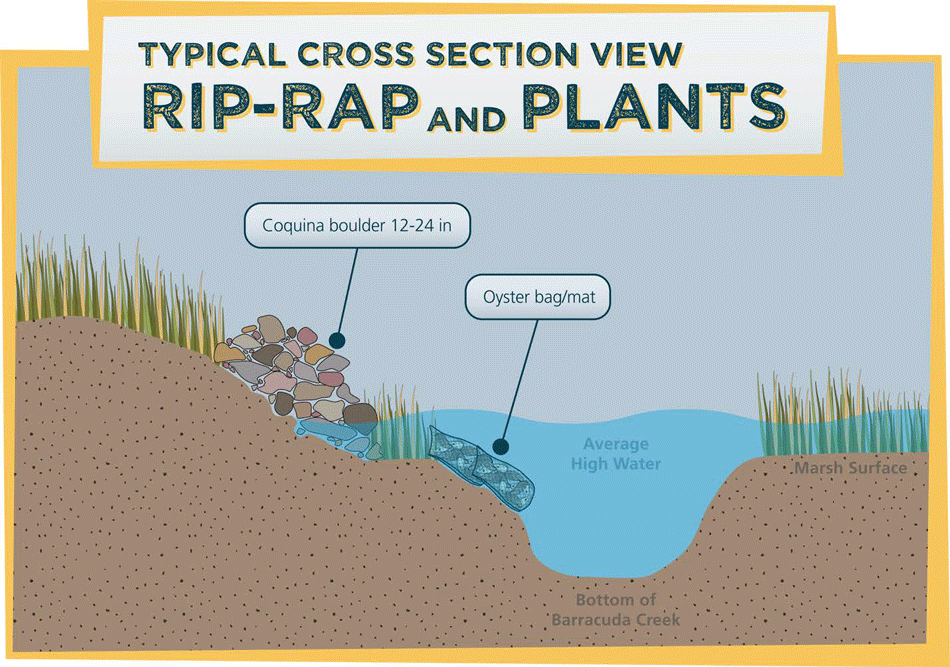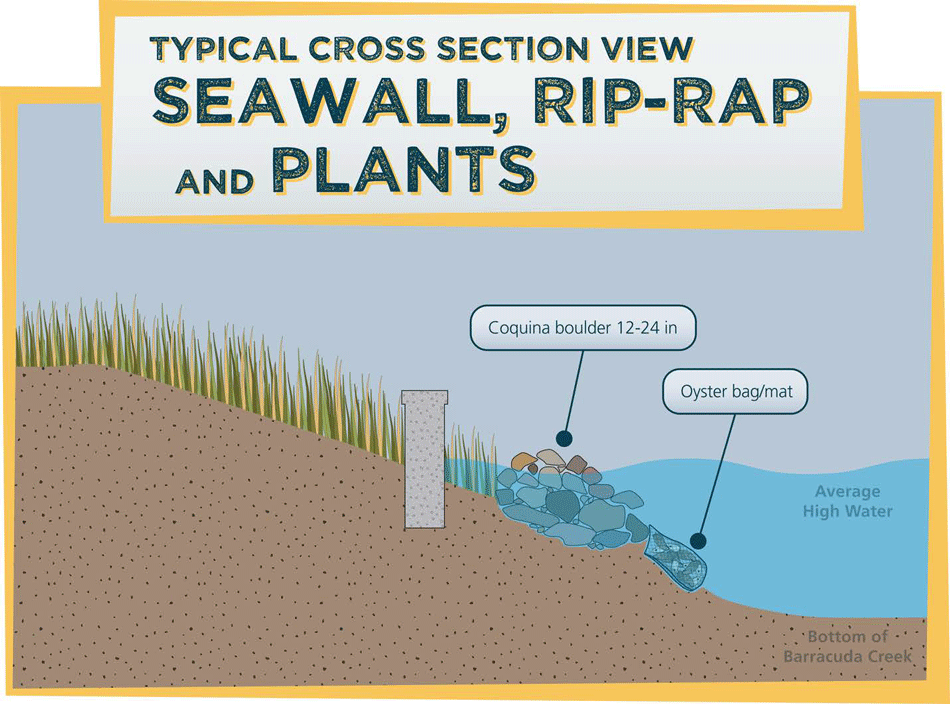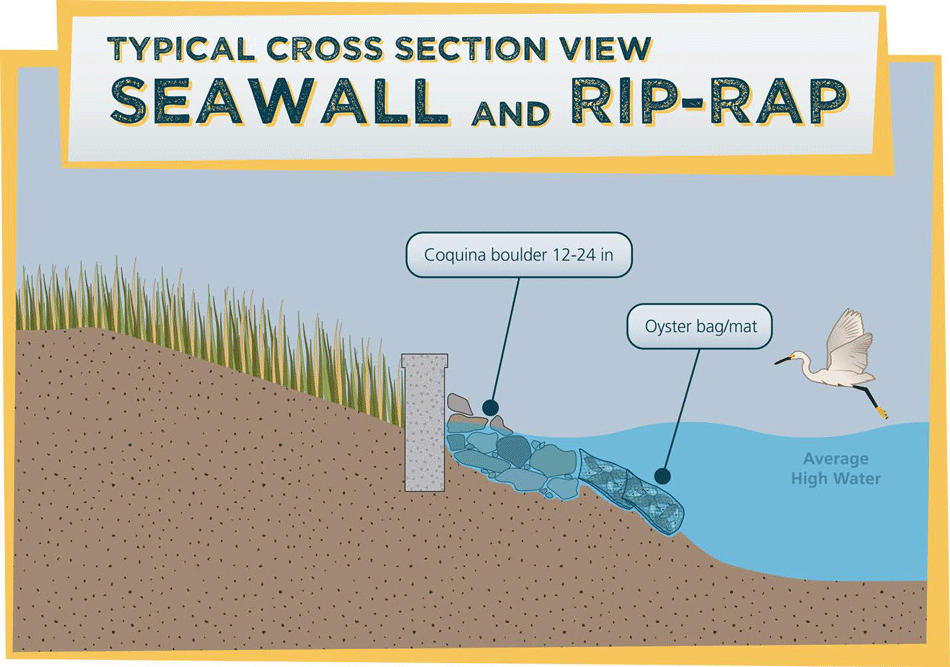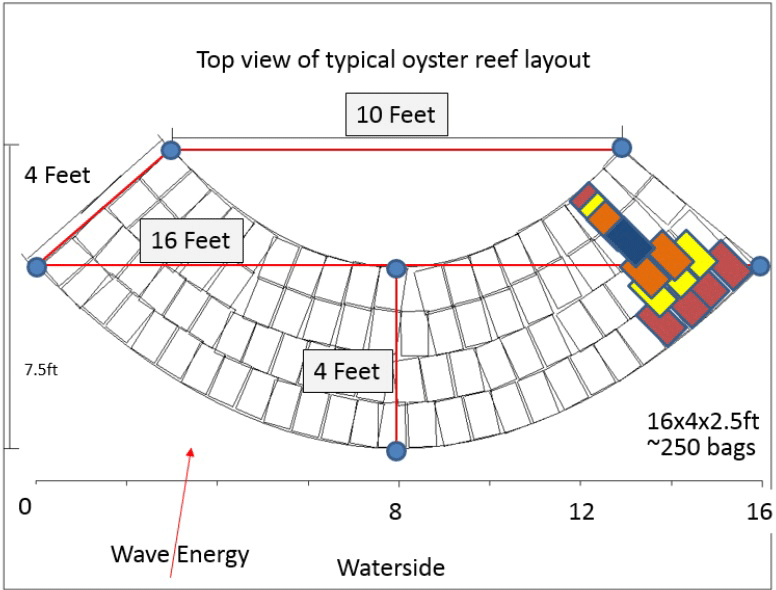Types of Living Shorelines
As shoreline hardening and “living shoreline” construction have increased around coastal areas, so has discussion about what a living shoreline (LSL) is or should be. At what point on the continuum of shoreline protection treatments, from the “do nothing” and untreated approach to vertical hardening with seawalls and bulkheads, does a project include too much hard material to be classified as a living shoreline (LSL)? Although use of soft shoreline stabilization techniques is being encouraged, the definition of a LSL, as well as construction where needed and appropriate, can be subjective.
The shoreline protection treatments illustrated below should meet the criteria for most, if not all, LSL and hybrid LSL definitions. They are presented from the simplest LSLs (in which native vegetation is planted along a sloping shoreline profile) to the more constructed “hybrid” LSLs, which can include native limestone rip rap rock together with plants and oyster reefs. Two “redeemed seawall” designs, in which limestone rip rap and natural elements are installed seaward of the seawall, are also included.
Living Shoreline – Slope, Plants & Oysters
At a site with low to moderate wave energy and a gradual slope, native plants can stabilize the shoreline with their roots. They also provide habitat for fish and wildlife, and help cycle nutrients through the system. Different plant species are suitable for three different zones along the coast based on elevation. Oyster reef at the base of the planted slope provides a wave break, water filtration, and habitat for aquatic species.
- Plants only (saltmarsh, mangroves)
- Plants + coir logs
- Plants + oyster reef breakwater
Living Shoreline – Terracing, Plants & Oysters
At a site with a relatively steep slope, the steepness can be broken up by installing terraces (platforms) which contain native plants. The terraces are created by installing short walls of wood, stone, or other materials which hold a platform of soil behind them. Within each platform, native plants hold the soil with their roots while providing habitat. In this manner, rain run-off collects within each terrace, watering the plants and reducing erosion forces. Therefore, the walls must be sturdy to support soil, water, and plants. Flowering plants are especially popular for terracing and attract birds and butterflies. At the base of the slope, aquatic plants and oyster reef provide stabilization and habitat.
Hybrid Living Shoreline – Retaining Wall, Plants & Oysters
At a site with a combination of steep slope and low/moderate wave energy, a hybrid system of a retaining wall with native plants/oyster reef is sometimes appropriate. The retaining wall is far up slope from the waterline and never receives wave energy even at the highest tides. It functions to hold a significant portion of the soil on the slope and must be substantial (made from wood, concrete, stone, vinyl) and sunk deep into the hillside. Native plants can be placed above and below the wall to secure the slope and to provide habitat.
Hybrid Living Shoreline – Native Limestone Rip rap & Oysters
Rip-rap is a sloped barrier of rocks that can protect shorelines by absorbing wave action, especially useful in areas with moderate/high wave energy. It also provides some habitat for marine organisms that can live on the rocks or in the crevices between them. Rip-rap made of natural limestone (coquina) is generally recommended, as it supports native plant and animal species, slowly breaks down into sand/shell, and provides a surface for oysters to settle. Rip-rap often needs to be placed upon filter cloth which allows water to pass through but traps sediment, reducing erosion under the rocks.
Hybrid Living Shoreline – Native Limestone Rip rap, Plants & Oysters
Rip-rap is more effective when partnered with native coastal plants and an oyster reef constructed at the base. The plants and oyster provide extra protection against erosion and habitat for fish and wildlife. In order to promote plant growth, the rip-rap type, size, and placement must be carefully considered. It can be placed to form pockets of dense plants protected by surrounding rocks. Natural limestone (coquina) rip-rap is recommended to promote native plants.
Redeemed Seawall – Existing Seawall, Plants, Native Limestone Rip rap & Oysters
When adding improvements to a seawall in the form of rocks, rubble, or oyster reef, plants can be included in the design. One technique is to create a breakwater of rip-rap offshore of the seawall and a planter between them. Native aquatic plants can provide stability to the wall while providing habitat for fish and wildlife.
Redeemed Seawall – Existing Seawall, Native Limestone Rip rap & Oysters
Seawalls are hardened structures designed to reduce erosion in areas of moderate/high wave energy. Usually constructed of concrete, wood, or vinyl, they form a vertical barrier between land and water. While they can be effective in the short-term, they can be expensive to build and maintain. Because they are a fixed height, waves can crash over them during storms leading to erosion, wall damage, or collapse. Seawalls can fail when waves erode their bases and they provide minimal habitat for fish and wildlife. They can be improved, however, by adding rip-rap in the form of rocks, rubble, or oyster reef. In this manner, wave energy is dissipated and habitat value is added waterward of the wall.
Check out these helpful guides for more information:
LSL Planting Considerations:
- Low tide — Planting on a low tide, regardless of season, is very important for success in establishing Spartina alterniflora (smooth cordgrass), which can grow in the deepest water along the upland-to-wetland profile and can remain submerged the longest. The higher the tide, the harder it is to install smooth cordgrass
- Planting depth — Since winter tends to experience more extreme tidal range, and summer tends to have more storm activity, our most favorable tidal conditions for planting are fall and spring.
- Healthy plants – Healthy plants with established, actively growing roots are best to ensure planting success. They are planted in staggered rows, about 1 foot apart, along the profile in the zone where their specific moisture/salinity requirements are met (link to plant list)
- Native plants – use only natives
- Geographic location – use only native plants appropriate for the climate and conditions. Salt marsh occurs all along the Florida coastline, so salt marsh plants are likely to be an appropriate choice. Mangroves, however, should not be used in Northwest and much of Northeast Florida.
- Zonation should be considered: plant along the entire wetland-upland profile
- Spacing
- Grade
- Invasive/exotics – remove prior to LSL construction, and plant only natives
- Monitoring
- Maintenance
LSL Oyster Reef Considerations:
Oyster shell
Recycled oyster shell from restaurants puts shell back into the natural system instead of wasting it by placing it in a land-fill, and saves money on disposal costs. Local programs have been started in various communities in Florida:
- Offer Your Shell To Enhance Restoration ( http://keeppensacolabeautiful.org/what-we-do/beautification/oyster_1/shell-recycling.html)
- Shuck and Share (http://shuckandshare.org/)
- Florida Oceanographic Oyster Restoration (https://www.floridaocean.org/p/19/florida-oceanographic-oyster-restoration-fl-o-o-r#.WZ7OyW_D9i9)
- Fossilized oyster shell from a quarry is heavier, so it’s sturdier for higher energy projects, but it’s also heavier to handle. It is readily available, can be delivered in bulk, and can be cheaper than recycled shell.
Because loose shell can be more easily moved by waves before growth of new oysters can occur, loose shell is packed in aquaculture grade mesh bags before being used in oyster reef creation. Bags contain the shell in a project’s allowable footprint and should withstand degradation long enough to allow oysters to build consolidated reefs around them.
Oyster reef construction:
Photo by Florida DEP
- Cresent – shape design with stacked bags of oyster shell.
- Each rectangle in the diagram represents one bag.
- Each reef unit includes about 200 bags of shell, which weighs about 4,000lbs.
- When multiple reef units are installed, as is usually the case, gaps (5 feet between longer reefs) must be placed between them to allow for large animal passage and water circulation.
- Permits require that the shoreward edge of the reef be placed less than 10 linear feet below mean high tide.
For more information about oyster restoration, including up-to-date research, reports, and the use of oysters in living shorelines, visit www.oyster-restoration.org.

